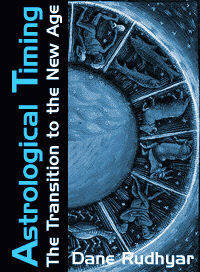 |
| Home | Bio | Art | Music | Literature | Civilization & Culture | Philosophy of Wholeness | Theosophy & Spirituality | Astrology |

ASTROLOGICAL TIMING
The Transition to the New Age by Dane Rudhyar, 1969 First published under the title Birth Patterns for a New Humanity
CONTENTS
PROLOGUE Where Do We Stand Today? PART ONE 1. Three Centuries of Crisis 2. Planetary Cycles 3. Cycles of Relationship Page 1 PART TWO 4. Stars, Constellations and Signs of the Zodiac 5. From Buddha to Christ 6. The Structure of the Piscean Age Page 1 Page 2 Page 3 Page 4 Page 5 Page 6 Page 7 7. At the Gates of the New Age 8. The Aquarius-Leo Age PART THREE 9. The Zodiacal Earth-Field 10. As We Face the Future EPILOGUE |

CHAPTER SIX
The Structure of the Piscean Age - 6 XI. 1702 to 1882 AD This "eleventh House" period is fittingly an age of radical political, then social revolution and transformation. It can also be divided into two 90-year phases. From 1703 to 1793, we witness the political revolutions in America and in France, with their background of intellectual struggle against the authority of King and Church. From 1792 to 1882 the Western world experiences the momentous industrial and social-spiritual revolution which poses all the problems which confront our tragic twentieth century. The "political revolution" phase represents the involutionary descent of the new spirit; the "industrial revolution," the evolutionary ascent of new levels of humanity and of mental thought in answer to the challenges of this new spirit. Uranus (discovered in 1781) symbolizes the first phase; Neptune (discovered in 1846), the second. The abstract (then emotional) idealism of these eighteen decades, the fervor and hopes and wishful dreams of the great Romanticists — from J. J. Rousseau to Victor Hugo, from Thomas Paine to Fourier or Karl Marx, from the English Locke to the American Lincoln and the Russian Kropotkin — the collective yearning to build a new world, and the seership of Prophets who envision new patterns of society; all these things (and their dark shadows: national imperialism, bourgeois greed and Victorian hypocrisy) are typical expressions of the eleventh House in astrological symbolism. To understand these historical phenomena as "eleventh House" characteristics gives to the astrologically minded historian a new insight in this crucial sequence of events and cultural developments. It adds a "new dimension of understanding," a cyclic dimension. And, using it, new and most significant historical correlations can be made. For instance, we can compare the sudden spread of Islam during the fifth House period of the Piscean Age to the colonial imperialism of Europe during the eleventh House period, its astrological polarity. Dark Ages there were on the European continent, as the Roman Empire became completely liquidated and Asiatic peoples crashed the gates of Europe. A whole half-cycle later, it is Europe's turn to invade Asia and Africa; and the era of conflicting nationalisms and scientific materialism can also be considered a "dark" period from the point of view of the universalistic character of spirit. The great Catholic (i.e., universal) Order of the seventh, eighth and ninth Houses period (983-1523) thus is shown also to correspond to the Roman Empire of the cyclically opposite first, second and third Houses period of the Piscean Age (99 BC to 443 AD). These and similar correspondences or polar relationships are not only significant in terms of a more coherent and vital understanding of the past, they enable us to orient ourselves toward the future, now in the making during the last of the twelve House-subdivisions of the Piscean Age, in which we are still living. By permission of Leyla Rudhyar Hill Copyright © 1969 by Dane Rudhyar and Copyright © 2001 by Leyla Rudhyar Hill All Rights Reserved.  Web design and all data, text and graphics appearing on this site are protected by US and International Copyright and are not to be reproduced, distributed, circulated, offered for sale, or given away, in any form, by any means, electronic or conventional. See Notices for full copyright statement and conditions of use. Web design copyright © 2000-2004 by Michael R. Meyer. All Rights Reserved. |
 |